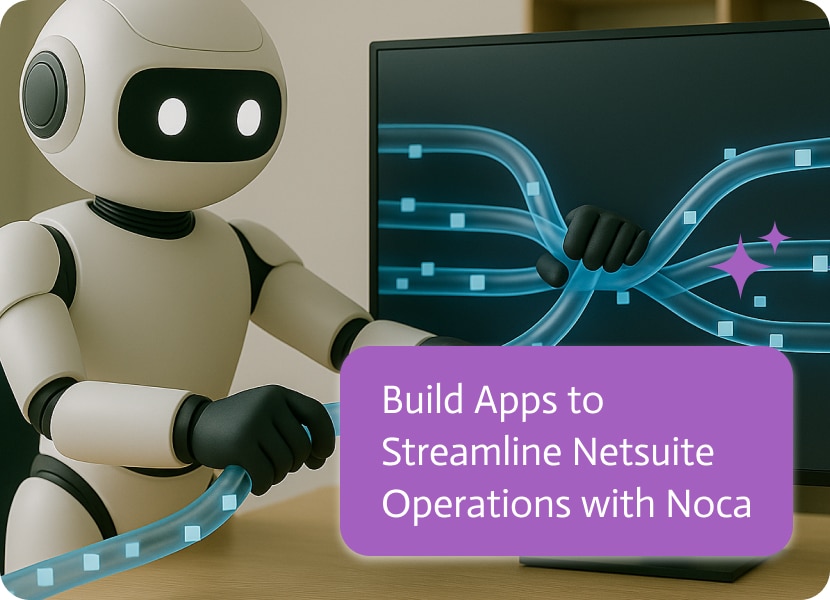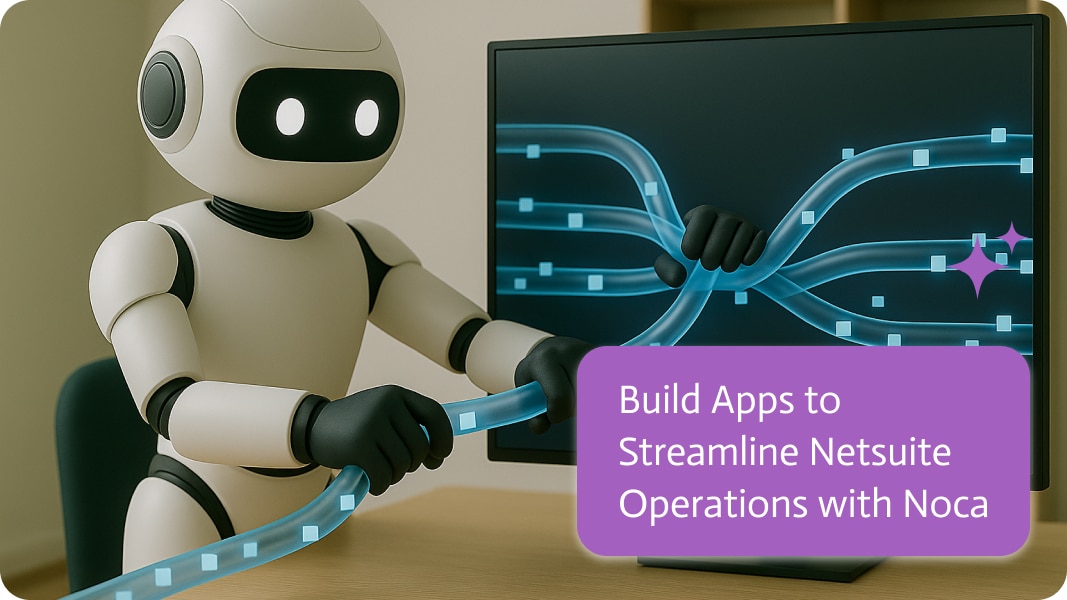

NetSuite Operations Vibe Coded Apps
In the modern enterprise, software has a double edge. The same systems meant to make things run smoother can actually create hold-ups when business needs change faster than the software can keep up. A prime example of this is Oracle NetSuite, a leading cloud ERP system trusted daily by over 37,000 organizations. Although it’s scalable and robust, it can feel rigid when teams try to adjust workflows to fit their particular circumstances.
The answer has traditionally been expensive customization or manual workarounds, solutions that may work temporarily but inevitably add friction. This is where Noca comes in with a different approach: rapid app creation by using plain language. By letting teams build internal tools on top of NetSuite without traditional coding, it’s changing how we use everyday tools.
An AI chat bot can further enhance this experience by helping users navigate workflows, answer questions in real time, and trigger actions directly within NetSuite, making automation even more accessible.
The result? Automating purchase order approvals, operations are able to design custom systems, and every department can now build notification workflows, all without waiting weeks for IT intervention. This marks a major shift in the way enterprises think about ERP agility.
Why NetSuite Became a Cornerstone and a Challenge
Understanding why Noca and its vibe coding abilities are bound to become even more important, it helps to look at how NetSuite established its place in the enterprise ecosystem. Launched in 1998, NetSuite was one of the first cloud-native ERP systems at a time when most competitors still relied on heavy, on-premise deployments. The pitch was simple but revolutionary: manage everything from financials to customer data in the cloud, allowing it to be accessible from anywhere.
NetSuite quickly became the ERP of choice for mid-market firms that couldn’t afford the sprawling implementations of SAP or Oracle’s legacy offerings. By the 2010s, its reach extended to enterprises, culminating in Oracle’s $9.3 billion acquisition in 2016. Since then, Oracle has positioned NetSuite as the backbone for cloud-first enterprises, with features spanning accounting, procurement, inventory, CRM, and HR.
But with that wide range of features comes rigidity. The system is excellent at enforcing structure, however, adapting to every detail of a business usually means you need technical expertise. SuiteScript, NetSuite’s customization language, is powerful but inaccessible to non-developers. Many organizations end up with long backlogs of customization requests, leaving employees stuck doing things manually in the meantime.
From No-Code to Vibe Coding
The last decade has seen the rise of no-code and low-code platforms, a movement fueled by frustratingly slow IT cycles. Tools like Airtable, Zapier, and Retool gave non-technical users the power to create apps, prompt to flow, and dashboards without writing any code. Even though these tools proved transformative, they often operated outside core systems like ERPs, creating parallel data silos.
Noca takes a different approach. Rather than building apps on the side, it integrates directly with business systems like NetSuite. Coined by Andre Karpathy, it’s now described as “vibe coding,” and basically lets users type or speak in plain English what they need, and the platform translates that intent into functional apps.
These days a procurement manager could simply tell Noca:
“Set up an approval flow so that any purchase order above $15,000 requires dual sign-off, and send a Slack message to the finance director.”
Noca creates the workflow, connects it to NetSuite data, and makes sure rules are followed. What used to take weeks of developer time can now be prototyped in hours.
Where the Real Gains Are Made
The value of building apps with Noca is not abstract; it shows up in the trenches of day-to-day operations. Here are a few situations where it can make a big impact:
- Procurement Efficiency. Traditional purchase order approvals in NetSuite often involve back-and-forth emails or manual status checks. A workflow built with Noca sends approvals instantly, keeps records for compliance, and notifies the correct person, helping reduce turnaround delays by as much as 60%.
- Operations Scheduling. NetSuite is good at handling inventory and project data but isn’t always flexible, especially when it comes to scheduling. A Noca app can align schedules to live inventory levels, automatically flagging shortages or rescheduling work when bottlenecks appear.
- Finance Notifications. Rather than checking dashboards manually, finance divisions will receive real-time alerts when invoices cross thresholds, expenses exceed budgets, or cash flow signals risk.
- Role-Specific Dashboards. Executives rarely want the same data views as department leads. With Noca, tailored dashboards are spun up quickly, pulling directly from NetSuite without requiring IT-built reports.
Each of these examples addresses a friction point where people currently fill the gap with spreadsheets, side emails, or late-night number crunching. Automating those pain points means fewer errors, faster cycles, and execution that is far more consistent.
Why Bottlenecks Persist in NetSuite Operations
Experts in ERP management often point to four recurring reasons why bottlenecks remain in organizations using NetSuite or similar systems:
- Approval fatigue: As companies grow, approval hierarchies become more complex. Without automation, processes like procurement or expense sign-offs become chokepoints.
- Rigid reporting: Built-in dashboards often don’t provide the details decision-makers need. Custom reports require IT time, creating delays.
- Integration gaps: Even within NetSuite, modules don’t always speak to each other the way you require, which leads to the same work being redone.
- Change inertia: Many IT leaders hesitate to greenlight custom development because of cost and long-term maintenance burdens.
Noca’s model sidesteps these problems by shifting the power dynamic. Instead of business units waiting for IT, they can co-create solutions. This gives IT the chance to provide guidance. This addresses the most common cause of inefficiency: the lag between recognizing a problem and deploying a workaround.
The Numbers Behind the Shift
According to Gartner’s 2025 forecast, 70% of new enterprise applications will be built with low-code or no-code technologies, up from less than 25% in 2020. Meanwhile, research from McKinsey shows that companies that systemize approval workflows cut turnaround times in half while reducing the risk of compliance issues.
For NetSuite customers, the financial case is an especially strong one. Custom SuiteScript development often costs $100–200 per hour for outside consultants, with projects ranging into the tens of thousands. By contrast, building apps with Noca allows deploying iterative solutions at a fraction of the cost.
ERP Flexibility and the Future of NetSuite Operations
What does the future hold for Noca in the NetSuite ecosystem? Several trajectories stand out.
First, expect hyper-personalized interfaces. Instead of a one-size-fits-all NetSuite dashboard, every employee could have a role-specific app automatically generated from their daily tasks.
Second, apps will move from reactive to predictive. It’s a system that doesn’t just route purchase orders but even makes predictions on approval bottlenecks and, thanks to previous info, proactively reallocating requests.
Third, ERP layers will become cross-system by default. Already, many companies want their NetSuite to connect effortlessly with Salesforce or Slack. In the future, Noca-style platforms will orchestrate across a variety of enterprise systems, creating a unified operational fabric.
Finally, organizations will need new governance models. While democratized app creation offers epic potential, it could easily turn into chaos without oversight. IT departments will probably develop into enablement hubs, setting standards and guaranteeing security, allowing business units to innovate.
New Methods from Early Adopters
Companies experimenting with Noca in NetSuite environments are starting to converge on some approaches:
- Start with a single pain point, like purchase order approvals, to show quick wins.
- Keep business stakeholders engaged throughout the build process, instead of having IT act as a separate gatekeeper.
- Encourage iteration: apps are living tools that should flex and adapt with changing needs.
- Balance oversight with autonomy by setting clear governance rules regarding security and access.
This blended approach benefits from flexibility while not compromising compliance or stability.
Conclusion: Turning NetSuite Into an Agile Engine
NetSuite will definitely play a major role in enterprise operations for years to come, but how companies use it is changing. Where once customization meant expensive consulting projects or clunky manual workarounds, tools like Noca now allow teams to build what they need on their own terms using a prompt-to-app approach.
When approvals move faster, capital flows more easily. When dashboards reflect real decision-making needs, leaders act with more confidence. When scheduling aligns automatically with inventory, operations waste less time and money. In short, when bottlenecks disappear, organizations run at their true potential.
The bigger story, however, is not just about NetSuite. It’s about a shift in enterprise software culture, from systems dictating processes to processes shaping systems. Noca isn’t replacing ERPs; they’re making them human again, adapting them to the realities of the actual work teams need to do.
The businesses that jump on this shift will discover that efficiency is no longer locked behind IT backlogs or consultant invoices. Instead, it will live in the hands of the very people closest to the work, empowered, for the first time, to design the tools that keep their businesses moving.


